We're much more organised this year, starting coppicing just before the beginning of October, rather than December like we did last year! But before I get onto that, here's a few pictures of some creatures that still think it's summer. A peacock butterfly and a dragonfly, both sunning themselves in the afternoon:
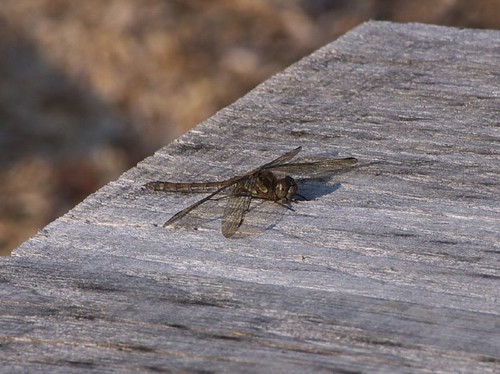 The robin however was busy shouting, perhaps marking his territory for the coming winter?
The robin however was busy shouting, perhaps marking his territory for the coming winter?  He took great interest in the work I was doing, which was making stakes ready for log stores (this was on Sunday).
He took great interest in the work I was doing, which was making stakes ready for log stores (this was on Sunday).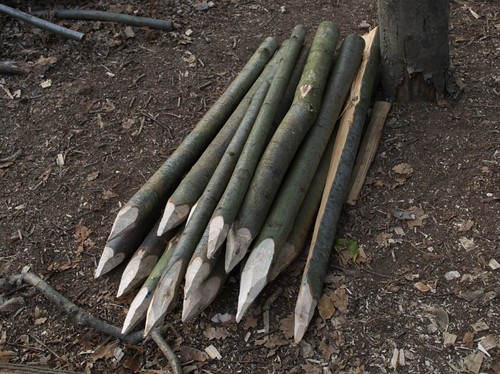 The rabbits are still out and about in the wayleave, as I expect they will be all through the winter:
The rabbits are still out and about in the wayleave, as I expect they will be all through the winter: The fungi, however, are clear that it is time to be fruiting...
The fungi, however, are clear that it is time to be fruiting... This one's growing on a chestnut coppice stool:
This one's growing on a chestnut coppice stool: These are fly agaric, but almost finished and have changed in colour dramatically from how they look when fresh,
These are fly agaric, but almost finished and have changed in colour dramatically from how they look when fresh, Anyway, I had today off work, and Tracy had a bit of time free late morning, so we went up the wood and started on the coppicing. This year we're cutting a few metres on either side of all the rides and paths that border or run through Chestnut Coppice and Sweep Wood. As we're working nearer to the public we've taken out third party insurance, though today not a single person walked down the public footpath!
Anyway, I had today off work, and Tracy had a bit of time free late morning, so we went up the wood and started on the coppicing. This year we're cutting a few metres on either side of all the rides and paths that border or run through Chestnut Coppice and Sweep Wood. As we're working nearer to the public we've taken out third party insurance, though today not a single person walked down the public footpath!
The reason for cutting these areas is to create wide "corridors" with more light, which will allow a greater diversity of plant and animal life, as well as yielding some useful wood for us to sell. Butterflies and birds in particular should benefit from this work, as some of them don't fly through dark woods, so the corridors will form routes they can follow to get to other parts of the wood.
Here's how the public footpath looked before we started, it'll be interesting to compare this photo to one when we've finished...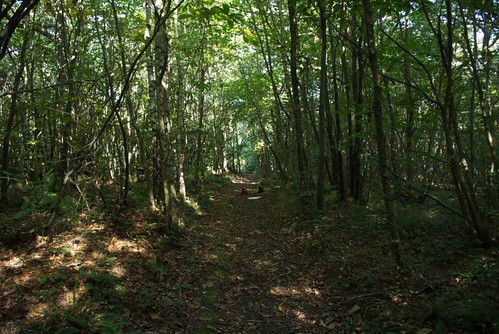 The area we started on today was where the footpath meets the wayleave:
The area we started on today was where the footpath meets the wayleave: On either side were some birch, some of which had already been coppiced once before:
On either side were some birch, some of which had already been coppiced once before:
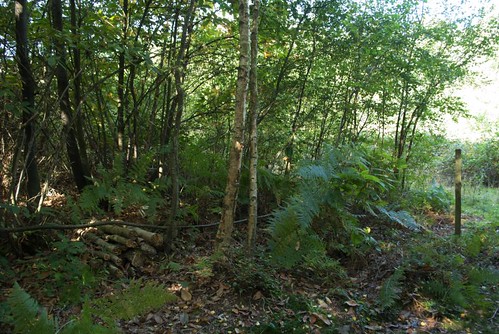 Having learnt from last year's work we're taking a different approach this year. The trees will be felled, then if we know the final use they will be processed where they land, and stored at the side of the ride ready for extraction in the spring. This should minimise unnecessary carrying around of wood, and also ensure our firewood is thoroughly dry.
Having learnt from last year's work we're taking a different approach this year. The trees will be felled, then if we know the final use they will be processed where they land, and stored at the side of the ride ready for extraction in the spring. This should minimise unnecessary carrying around of wood, and also ensure our firewood is thoroughly dry.
For the birch we were felling today, this strategy meant cutting them into short logs as they were felled. We're planning to save up all the splitting work until the weekend, so we can minimise chainsaw noise for the neighbours.
While I was doing the logging, I came up with a neat way of holding a log firmly to be sawn up: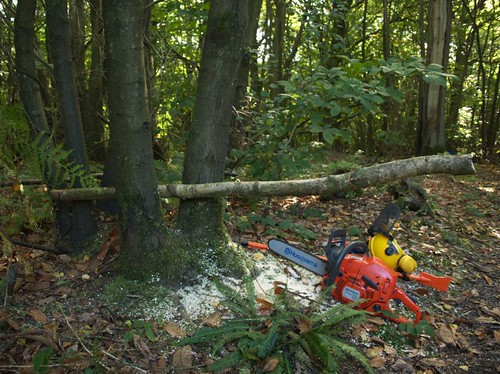
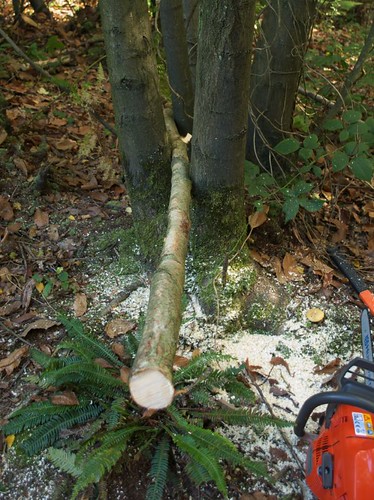 Tracy felled a few trees further up the path (as we worked two tree-lengths apart for safety), but then had to go to work at WoodNet, and I carried on near the stile. I felled about 10 trees, plus a lot of smaller birch out in the wayleave, to make a clear path for the wildlife to make its way in. The extra light getting in was immediately apparent:
Tracy felled a few trees further up the path (as we worked two tree-lengths apart for safety), but then had to go to work at WoodNet, and I carried on near the stile. I felled about 10 trees, plus a lot of smaller birch out in the wayleave, to make a clear path for the wildlife to make its way in. The extra light getting in was immediately apparent: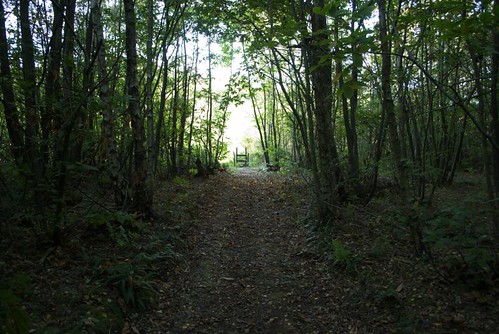
 I was left with a few neat piles of logs ready for splitting:
I was left with a few neat piles of logs ready for splitting: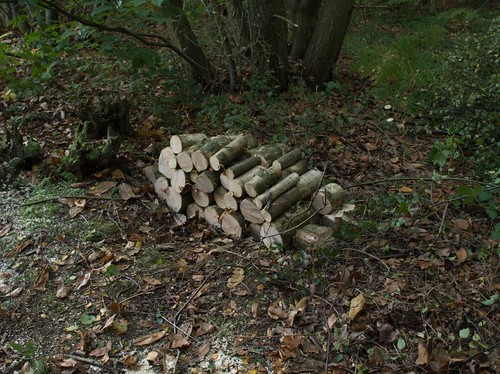
 and was particularly pleased to have been able to avoid cutting this honeysuckle, which I managed to drape over the fence and a tree that we won't be felling.
and was particularly pleased to have been able to avoid cutting this honeysuckle, which I managed to drape over the fence and a tree that we won't be felling. There are still a couple of birch stems to fell in this spot, but time ran out. We'll be up there again on Thursday or Friday to carry on, and on Saturday we're hosting a Fungi ID event, as the wood it should have been held in has no fungi right now, while ours has loads.
There are still a couple of birch stems to fell in this spot, but time ran out. We'll be up there again on Thursday or Friday to carry on, and on Saturday we're hosting a Fungi ID event, as the wood it should have been held in has no fungi right now, while ours has loads.
Mike
Monday, 29 September 2008
Start of coppicing!
Sunday, 28 September 2008
A beach, a wind farm, a nuclear power station and some birds: cycling from Rye to Dungeness
Yesterday we cycled from Rye to Dungeness and back on our electric bikes, a 30 mile round trip (the batteries could probably have lasted another 10 miles I think). First stop was Camber, where we paused at the shingle banks to the east of the village: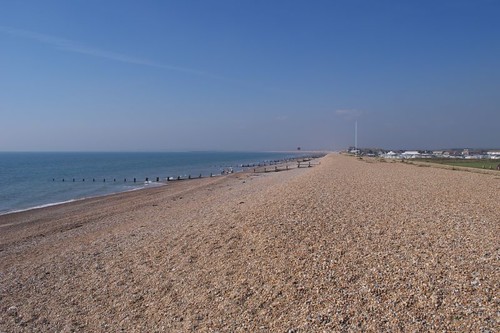
 It was about lunchtime so we stayed a short while there. You can see the Romney Marsh wind farm behind Tracy in this picture:
It was about lunchtime so we stayed a short while there. You can see the Romney Marsh wind farm behind Tracy in this picture: Here's a better view of it:
Here's a better view of it: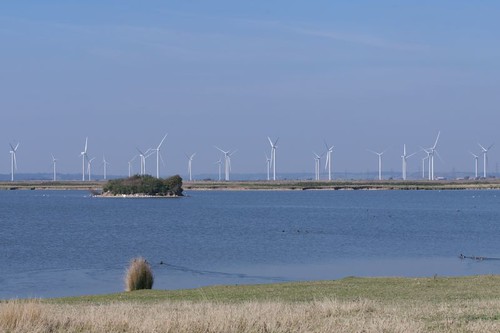 It includes 26 turbines, which are now all up. Apparently they have to build some meteorological equipment and then they can start commissioning them, with the whole lot scheduled to be running by January 2009.
It includes 26 turbines, which are now all up. Apparently they have to build some meteorological equipment and then they can start commissioning them, with the whole lot scheduled to be running by January 2009.
While we had lunch a guy zoomed around on a jetski for our amusement...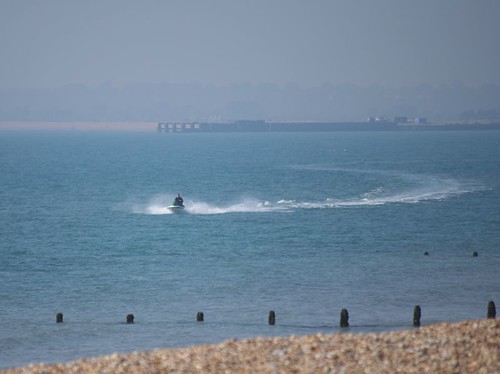
 and the local wildlife hung around to see if they could clean up any crumbs we left:
and the local wildlife hung around to see if they could clean up any crumbs we left: A bit further down the road towards Lydd we stopped by a large lake, which I think may have been formed by gravel excavation, which was still going on nearby.
A bit further down the road towards Lydd we stopped by a large lake, which I think may have been formed by gravel excavation, which was still going on nearby.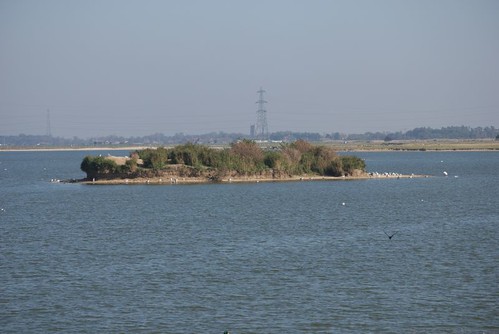 The far shore was carpeted with gulls:
The far shore was carpeted with gulls: while the shore near us was covered with Lapwings and some slightly smaller brown birds we haven't been able to identify. None of them liked the high-vis yellow vests we were wearing, so seeing as we were scaring them anyway I took the opportunity to get some photos:
while the shore near us was covered with Lapwings and some slightly smaller brown birds we haven't been able to identify. None of them liked the high-vis yellow vests we were wearing, so seeing as we were scaring them anyway I took the opportunity to get some photos:


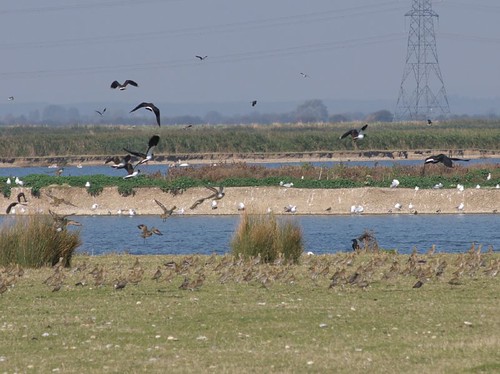 Before long we passed Lydd, and headed out into the wilderness. You can see why the MOD trains soldiers for Iraq and Afghanistan here:
Before long we passed Lydd, and headed out into the wilderness. You can see why the MOD trains soldiers for Iraq and Afghanistan here: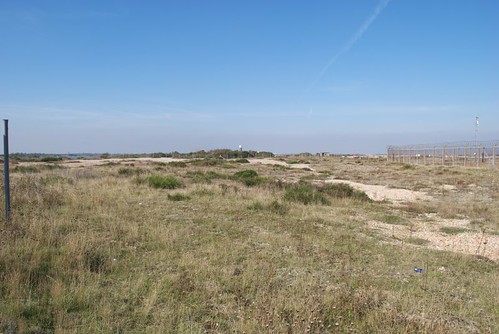 In the distance was Dungeness nuclear power station:
In the distance was Dungeness nuclear power station: and we rode past what looked like a facilty for transferring nuclear fuel containers from trains to trucks to go down to the power station:
and we rode past what looked like a facilty for transferring nuclear fuel containers from trains to trucks to go down to the power station: The road's quite long and desolate:
The road's quite long and desolate: though there was actually quite a bit of traffic on it.
though there was actually quite a bit of traffic on it.
As we approached Dungeness we saw that the RNLI lifeboat station was open, so we went in to have a look round, and bought a few odds and ends in their shop. Apparently they didn't get called out much this year, as the lack of warm weather reduced the number of people out on the sea. Impressive kit waiting there until it's needed though:

 From there we moved on into the village of Dungeness, which has the strangest collection of houses I've ever seen, many with the power station overlooking them:
From there we moved on into the village of Dungeness, which has the strangest collection of houses I've ever seen, many with the power station overlooking them: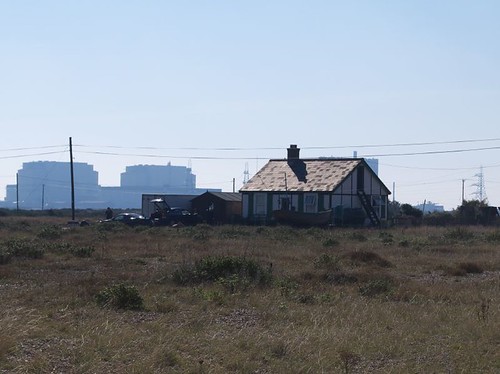


 and once you move away form the road it's back to wilderness
and once you move away form the road it's back to wilderness
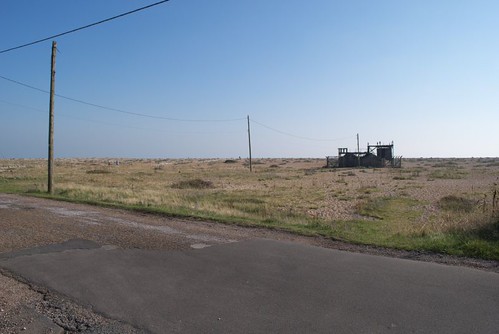 The furtherst point of our ride was marked by the Britannia Inn, which serves a good pint of beer.
The furtherst point of our ride was marked by the Britannia Inn, which serves a good pint of beer. and you can sit out the front in good weather, with the usual view:
and you can sit out the front in good weather, with the usual view: Mike
Mike
UPDATE, here's the photo I mentioned in the comments below, taken last year: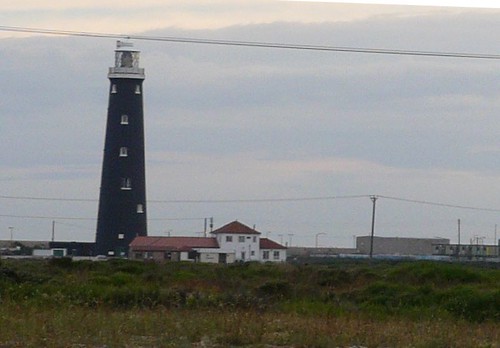
Tuesday, 23 September 2008
23 September: The day humanity starts eating the planet in 2008
On September 23, humanity will have used up all the resources nature will provide this year, according to the latest data from Global Footprint Network and its member organisation nef (the new economics foundation) who devised the concept of Ecological Debt Day. Just like any company, nature has a budget – it can only produce so many resources and absorb so much waste each year. The problem is, our demand on nature’s services is exceeding what it can provide. Since the 1980s, humanity has been in ecological overshoot, using resources faster than they can be regenerated and putting carbon into the air faster than it can be reabsorbed. Globally, we now demand the biological capacity of 1.4 planets. But of course, we only have one. The result is that our supply of natural resources – like trees and fish – continues to shrink, while our waste – primarily carbon dioxide – accumulates. “It took governments in the UK and US just a week to drop decades of hardened economic practice to save the financial system from meltdown, why should it take any longer to act to save the planet?” says Andrew Simms, nef policy director, “They say that big financial institutions are too big to fail, but there is something larger and much more important that is being allowed to collapse – a climate system conducive to human civilisation. There could be less than one hundred months to prevent catastrophic, runaway global warming. We need a programme from government now, that is at least as bold as action to save reckless financiers.”Read the full article here
Mike Click here to read the rest of this post.
Monday, 22 September 2008
Coppice stumps and flowers
As I've mentioned before, some of the coppice stumps we've cleaned up have been sold to people using them for flower arrangements. Here's some photos my Dad took of the last couple they took home to be sold for this use:
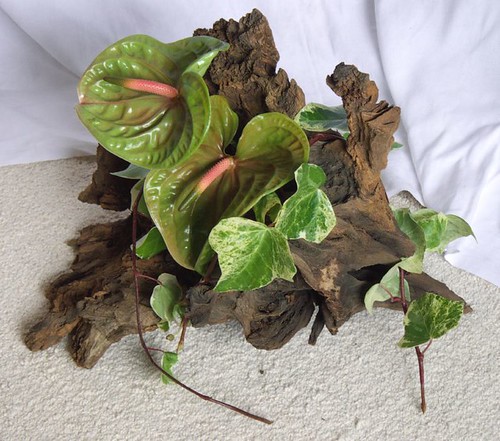

 Mike
Mike
